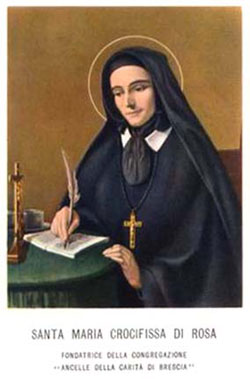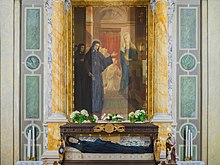
Feastday: December 15
Death: 1855
Saint Mary (Paula) Di Rosa December 15 The pounding on the barricaded door of the military hospital sent every heart thudding in terror. In the middle of the war in Brescia (Italy) in 1848, the wounded, sick, and those who cared for them knew what that pounding meant. The shouts from beyond the door came from soldiers, not obeying any command but their inner desire to destroy and plunder. Who could do anything to stop them? The only people here were some Sisters, the Handmaids of Charity, who devoted themselves to helping the sick. The doctors had not even wanted them there. The doctors wanted medical people who were secular and military, not nuns. And in the face of this new danger they were even more useless! Worse than useless -- because that Paula (as she was known) di Rosa was actually moving to open the door!
When the door swung wide, the soldiers saw their way blocked with a great crucifix held by Paula di Rosa and two candles held by two of the six sisters who stood by her. Suddenly their frenzy to destroy disappeared, and full of shame before this display of courage and faith, they slunk back into the shadows.
Throughout her life, Paula di Rosa was never afraid to open the door on a new opportunity to serve God, especially when she was unsure of what lay beyond. People who didn't know her well must have thought she was too frail and delicate for these ventures, but she came armed not only with her faith but boundless energy, intelligence, and hunger to serve.
Born in 1813, she had tackled enormous projects from the time she was seventeen, arranging retreats and special missions for her parish and setting up a women's guild. Because of all she accomplished, when she was only twenty-four she was asked to be supervisor of a workhouse for poor girls. After two years, she became concerned because there was no place for the girls to go at the end of the day. Night held special dangers for these girls and Paula wanted to give them a safe place to stay. The trustees refused to provide that place. For Paula the choice was easy -- she once said that she could never go to bed with a clear conscience if she had missed the chance to do some good. So she quit the workhouse to set up a boardinghouse for poor girls while helping her brother with a school for the deaf.
At 27 she stood before another door. She was appointed superior of the Handmaids of Charity, a religious society whose purpose was to dedicate all their time and attention to the suffering in hospitals. With her friends Gabriela Bornati and Monsignor Pinzoni, she won the respect of those who thought of these "handmaids" as intruders.
Then in 1848, her whole life seemed to fall apart. First she lost Gabriela and then Monsignor Pinzoni died, leaving her without the support and friendship she had come to depend on. War started in Europe and her homeland was invaded. Facing that kind of grief and turmoil, many others would have crawled into bed and pulled the covers over their head. But Paula had always seen opportunity in everything that came her way. War meant that many would be wounded and displaced by the war so she and her sisters went to work at a military hospital and even went out to the battlefield to give spiritual and physical comfort to the wounded and dying.
She died in 1855, going through the final door, unafraid and joyful to be joining her Lord forever.
In Her Footsteps :Mary di Rosa would go out at a moment's notice if she felt that someone needed her help. The next time someone you know needs your aid, don't put off helping and make excuses. Drop what you are doing and give them what they need.
Prayer : Saint Mary, you weren't afraid to take new opportunities. It's frightening when we are asked to do something that is different or new. We would rather stay in our safe and comfortable routines. Help us to embrace each obstacle in our path as a new opportunity to serve God. Amen
 Altar and funeral monument of Maria Crocifissa di Rosa in the Handmaids of Charity chapel in Brescia.
Altar and funeral monument of Maria Crocifissa di Rosa in the Handmaids of Charity chapel in Brescia.
Maria Crocifissa Di Rosa (6 November 1813 – 15 December 1855) - born as Paola Francesca Di Rosa - was an Italian Roman Catholic professed religious and the founder of the Ancelle della carità (1839). Di Rosa worked first at her father's spinning mill where she - with his encouragement - tended to the spiritual and material needs of the female workers while gathering several women to dedicate their collective efforts to caring for the poor; this formed the basis for the establishment of her religious congregation. Her apostolate prioritized tending to the ill in hospitals and to soldiers going to the front.
Her beatification was celebrated in mid-1940 and Pope Pius XII (who beatified her) canonized her over a decade later on 12 June 1954.
Life
Paola Francesca Di Rosa was born on 6 November 1813 in Brescia as one of nine children born to the rich industrialist Clemente Di Rosa and Countess Camilla Albani (from the noble Albani line).
Di Rosa was educated by the Visitation Sisters in their convent in Brescia; she left school after her mother died in 1824. She began working in her father's large spinning mill in Acquafredda where she took an instant notice of the working conditions; she became the manager when she turned nineteen. She began caring for the female workers and devoted herself to looking after their material and spiritual needs which was something that her father encouraged her to do. Her father began searching for suitors to have her married, but she turned each of them down. Di Rosa was upset that her father did this and confessed her disappointment to the priest Faustino Pinzoni who then spoke to her father to tell him that his daughter had another vocation in mind. Di Rosa lived at home for the next decade increasing her involvement in various forms of social work.
Brescia suffered from a cholera epidemic in 1836 and Di Rosa went to tend to ill in the local hospital. It was also around this stage that she directed a home for mute and deaf women and in 1840 began gathering a small group of women that would later evolve into her future religious congregation (first entitled a Pious Union). Her order became known as the Ancelle della carità and she later took her religious name and was vested in the habit after undergoing her formation and making her profession in 1852. Di Rosa directed her order to caring for the poor as well the sick since those were the main focus of her religious apostolate; she once said to her colleagues that "I suffer from seeing suffering". Her order received papal approval from Pope Pius IX in 1850 after having received diocesan approval from the Bishop of Brescia Carlo Domenico Ferrari in 1843.
Di Rosa died at a hospital in Brescia on 15 December 1855 after suffering from a prolonged illness.
Sainthood
The canonization process commenced under Pope Pius X on 10 December 1913 and she became titled as a Servant of God. The confirmation of her life of heroic virtue allowed for Pope Pius XI to title her as Venerable on 10 July 1932 while the papal confirmation of two miracles attributed to her on 25 February 1940 enabled Pope Pius XII to preside over her beatification on 26 May 1940.
Pius XII confirmed two additional miracles attributed to Di Rosa on 17 January 1954 and canonized her as a saint in Saint Peter's Basilica on 12 June 1954.





